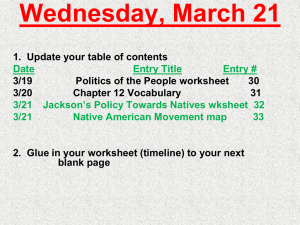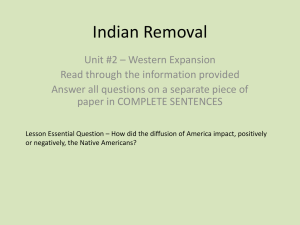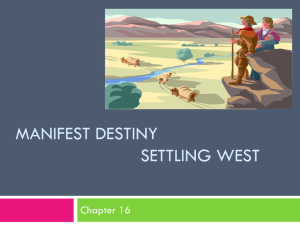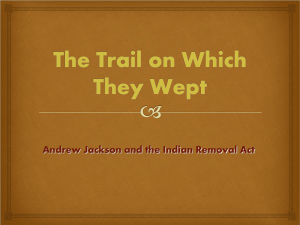Chapter One - Oklahoma Adventure
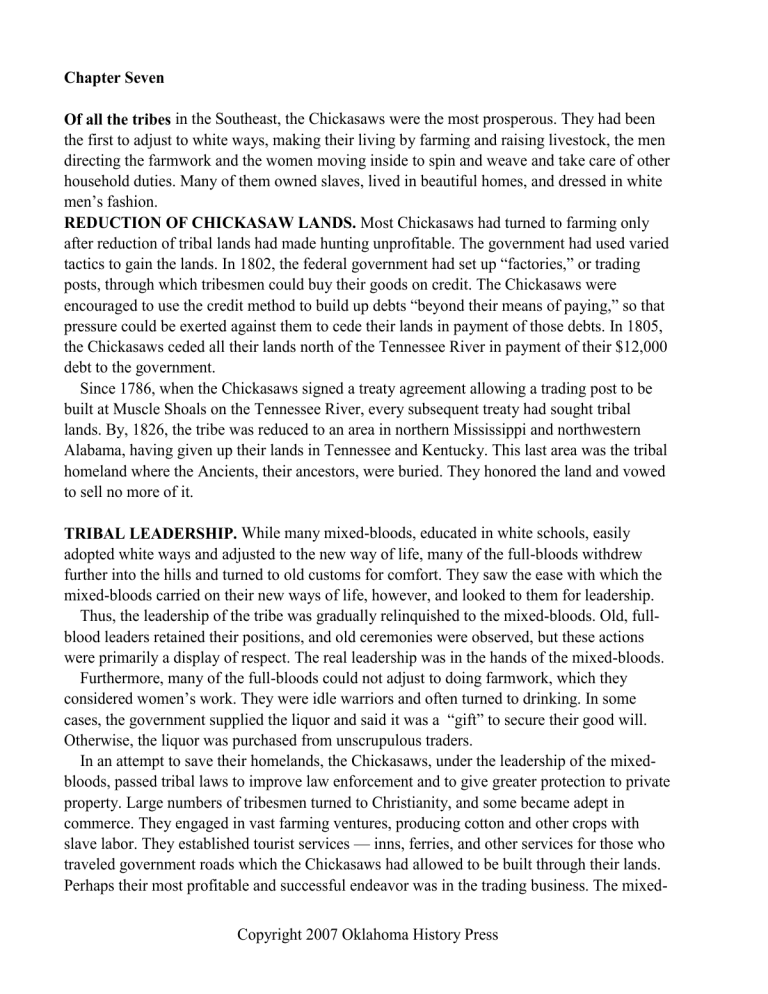
Chapter Seven
Of all the tribes in the Southeast, the Chickasaws were the most prosperous. They had been the first to adjust to white ways, making their living by farming and raising livestock, the men directing the farmwork and the women moving inside to spin and weave and take care of other household duties. Many of them owned slaves, lived in beautiful homes, and dressed in white men’s fashion.
REDUCTION OF CHICKASAW LANDS.
Most Chickasaws had turned to farming only after reduction of tribal lands had made hunting unprofitable. The government had used varied tactics to gain the lands. In 1802, the federal government had set up “factories,” or trading posts, through which tribesmen could buy their goods on credit. The Chickasaws were encouraged to use the credit method to build up debts “beyond their means of paying,” so that pressure could be exerted against them to cede their lands in payment of those debts. In 1805, the Chickasaws ceded all their lands north of the Tennessee River in payment of their $12,000 debt to the government.
Since 1786, when the Chickasaws signed a treaty agreement allowing a trading post to be built at Muscle Shoals on the Tennessee River, every subsequent treaty had sought tribal lands. By, 1826, the tribe was reduced to an area in northern Mississippi and northwestern
Alabama, having given up their lands in Tennessee and Kentucky. This last area was the tribal homeland where the Ancients, their ancestors, were buried. They honored the land and vowed to sell no more of it.
TRIBAL LEADERSHIP. While many mixed-bloods, educated in white schools, easily adopted white ways and adjusted to the new way of life, many of the full-bloods withdrew further into the hills and turned to old customs for comfort. They saw the ease with which the mixed-bloods carried on their new ways of life, however, and looked to them for leadership.
Thus, the leadership of the tribe was gradually relinquished to the mixed-bloods. Old, fullblood leaders retained their positions, and old ceremonies were observed, but these actions were primarily a display of respect. The real leadership was in the hands of the mixed-bloods.
Furthermore, many of the full-bloods could not adjust to doing farmwork, which they considered women’s work. They were idle warriors and often turned to drinking. In some cases, the government supplied the liquor and said it was a “gift” to secure their good will.
Otherwise, the liquor was purchased from unscrupulous traders.
In an attempt to save their homelands, the Chickasaws, under the leadership of the mixedbloods, passed tribal laws to improve law enforcement and to give greater protection to private property. Large numbers of tribesmen turned to Christianity, and some became adept in commerce. They engaged in vast farming ventures, producing cotton and other crops with slave labor. They established tourist services — inns, ferries, and other services for those who traveled government roads which the Chickasaws had allowed to be built through their lands.
Perhaps their most profitable and successful endeavor was in the trading business. The mixed-
Copyright 2007 Oklahoma History Press
blood councils succeeded in eliminating any permanent trading post from the Chickasaw
Nation not operated by a member of the nation. Further, they succeeded in demanding that treaty payments be made in “specie” or money rather than in goods, as had been the government’s practice with other tribes. Instead of giving blankets and tools and other goods to the Chickasaws in payment of treaty agreements, the government was obliged to pay them money. Then, when individuals received their portions of the money, they took it to a
Chickasaw-operated business and purchased their goods. This kept the money in circulation in the Chickasaw Nation rather than profiting outside suppliers.
REACTIONS TO CHICKASAW SUCCESS. Whites resented Chickasaw expertise and frequently wrote letters to Washington complaining that when whites traveled through
Chickasaw lands, there were only Chickasaws with whom to do business. In the minds of many whites, Indians should have been educated sufficiently to do menial tasks and to handle their everyday business by spending their money with white traders. They should never have been given enough education to go into business, and certainly should never have been put into a position to take white money into that business.
The Chickasaws planned to become acceptable to whites by living as whites lived. The plan failed, just as it had failed with other tribes, even though whites had insisted that this was the answer to the “Indian Problem.” Whites found the Indians even less acceptable as competitors than as aliens in their own country. The white cry for removal grew louder and louder, and
Chickasaw leaders began to see the inevitability of it, especially when state laws voided their sovereignty.
At first they tried to avoid it by ignoring it, saying simply that the Chickasaw Nation would not leave its homeland. Then they tried to prolong the date of removal by signing treaties which required Chickasaw leaders to explore the western lands and find a place “suitable” for the tribe.
TREATY OF PONTOTOC. In the Treaty of Pontotoc, first signed in 1832 and amended in
1834, the Chickasaws ceded all their lands east of the Mississippi River in exchange for lands in the West. More than six million acres of Chickasaw land was to be sold. The first of it went on the auction block in 1836, even before tribesmen had located a suitable new home in the
West. Chickasaws were moved to temporary locations on their former lands while the government sold their property to eager white buyers.
TREATY AT
DOAKSVILLE. Finally, on January 17, 1837, Chickasaw leaders signed an agreement with
Choctaw leaders in the West. At Doaksville, Choctaw Nation, the Choctaws agreed to sell a portion of the central and western areas of their nation in southern Indian Territory to the
Chickasaws for $530,000.
Copyright 2007 Oklahoma History Press
Meanwhile, in the East, while tribal leaders had tried to forestall the trauma of uprooting their people from their land and moving them to a strange new place, all semblance of protection by the federal government was abandoned. One government official remarked that an “alarming influx of disreputable whites” had made their way into the tribal lands and were mixing with the Indians, with disastrous results.
James Colbert, a mixed-blood leader, petitioned the President for help in forcing whites to comply with the treaties until the nation was removed. He related that many “speculators scoured the countryside...lying to the hapless Indians, telling them they must sign a blank deed to their property for $5.00 or less immediately and making promises they never intended to fulfill.” President Jackson ignored the plea.
Within a month of the signing of the Treaty at Doaksville, preparations were being made for the first emigration. The government decreed that each emigrating Indian have daily rations of one pound of fresh beef or pork, three-fourths of a pound of salt pork or bacon, three cups of corn or cornmeal or one pound of wheat flour, and 1/100th of a gallon of salt.
Contractors were to arrange to have rations deposited at various locations along the way, specifically at Memphis, Little Rock, and Fort Coffee. Each emigrating group was also to be assigned a conductor — someone to lead the way — a physician, and a disbursement officer
— someone to account for supplies at each depot and to see to the issue of rations.
FIRST REMOVAL. In late June, 1837, the first group of 450 Chickasaws moved out of
Chief Sealy’s district behind conductor John M. Millard. They crossed the Mississippi River from Memphis into Arkansas on July 4, and almost immediately encountered drenching rains so furious that the roads were completely washed out in many places. Camps were wet and fires were impossible. Dysentery and fever began to take their toll. The physician blamed these medical problems on Indian “dissipation” rather than on the conditions of travel.
In addition to poor weather, the Indians were subjected to bad rations. Many suppliers dumped rations on open docks or beside the road to rot in the sun. By the time the Indians arrived, the rations were spoiled.
The first group divided, and the ill and those in need were moved from Memphis to Fort
Coffee by riverboat, arriving there in a matter of days. A second group, after finding dry land and encountering no more rains, traveled at an amazing rate of thirteen miles per day. They arrived at Fort Coffee a few days later. The third group, however, choosing not to eat the spoiled rations supplied by the government, loitered in hunting camps, moving from zero to up to three miles per day. The more government officials urged them to hurry, the slower they moved. The men hunted deer, and the women and children worked in the camps and took care of the sick. Finally, threatened with troops to drive them onward, they continued their journey at a normal pace, arriving at Fort Coffee on September 5, 1837.
SECOND REMOVAL. A.M.M. Upshaw of Pulaski, Tennessee, had been appointed as superintendent of the Chickasaw removal, and while Millard conducted his charges through
Copyright 2007 Oklahoma History Press
the wilderness, Upshaw was busy readying for the second emigration. Some 4,000
Chickasaws were moved to emigration camps and marched from there to Memphis where they were to be removed to Fort Coffee by riverboats. The people would travel on the six riverboats owned by Simeon Buckner, a Kentuckian. Their livestock was to be loaded on barges and towed downriver by the boats.
The story of the accident in which a riverboat boiler exploded and many removing Creeks died reached the Chickasaw camp in Memphis. A thousand Chickasaws refused to travel by boat. Upshaw pleaded, threatened, and cajoled to no avail. When he threatened to stop their rations, a Chickasaw leader reminded him that the Chickasaws were paying for their own rations from the sale of their eastern lands, and Upshaw finally gave in. Three thousand
Chickasaws and their slaves were loaded onto the riverboats, and eight days later they arrived in Fort Coffee. Six weeks later, the surviving tribesmen finished the last of their overland journey — the heat, muddy swamps, unsanitary conditions, and spoiled rations having taken their toll.
Early in 1838 Upshaw dismissed his conductors and other contractors and reported to the government that his job was finished, and that only about twenty families remained in the
East, most of them slaves. He felt that they were capable of moving themselves. Actually, more than 500 Chickasaws remained in the East, and the government later offered $30 for the removal of each Indian or slave.
THIRD REMOVAL. Some widows were unable to move, their temporary homesteads having been taken over by “guardians” who kept them there for the use of the land. Some leaders had waited to emigrate, hoping to get a better price for their temporary homesteads.
These leaders — the Colberts, the Loves, and the Overtons among them — bought wagons and began moving their tribesmen west. These were some of the most successful removals made.
Some historians have criticized these mixed-blood leaders because they made a profit while
“helping” their tribesmen. Many widows, orphans, and destitute Chickasaws would have found the journey impossible, and many would have continued to suffer at the hands of unscrupulous whites who wanted to steal their allotments and their money, if it hadn’t been for these businessmen.
Even after the later trips were made and ended, Chickasaws continued to move west. Some of those hidden in the hills of their homelands did not move west until 1850.
IN INDIAN TERRITORY. Although the Chickasaws did not suffer as greatly on their removal journey as did the other tribes, their suffering didn’t stop when they arrived in Indian
Territory. Harassed by bands of Kiowas, Comanches, and other western tribes who resented the newcomers that they considered poachers, many Chickasaws remained in camps around
Fort Coffee and near the Choctaw towns. Contractors continued to supply spoiled food, and many Indians believed this was a real effort by the whites to destroy them.
Copyright 2007 Oklahoma History Press
Smallpox and other diseases killed more than 500 Chickasaws and the Choctaws who had come into contact with them. The Choctaws began to resent them. Gradually, however, the government controlled the western tribes and curbed their hostility so the Chickasaws could settle their new lands. Like the other tribes, they established towns and schools and farmed their lands. They had previously agreed to live under Choctaw government, but eventually they established their own government and lived on friendly terms with those around them.
Among the Five Civilized Tribes, the Chickasaws received the most crushing blow to an unconquerable spirit. A proud people with much foresight, they had adjusted to the new way of life of the whites who surrounded them. They had been successful in their implementation of that lifestyle. Their pride in their achievements and their hopes of survival for their tribe were crushed when they realized that even their success in the white economic system would not guarantee their acceptance.
Many full-bloods squandered their government payments in frustration and hopelessness.
The Chickasaws were the wealthiest and proudest of all the eastern Indian nations. They had the lowest mortality rate on their western journeys, but they lost the most in terms of spirit and finance and were perhaps the slowest of the five nations to recover.
The Cherokees were the first to give the western journey a name — “The Trail Where They
Cried,” later shortened to the Trail of Tears. Eventually, this name came to refer to all the removal journeys of the five southeastern tribes because of their sufferings and mortality rate.
THE OLD SETTLERS. Although most of the southeastern tribes had a few members who had moved west long before Indian removal became a government project, the Cherokees had the largest number. Traveling west of the Mississippi River to hunt, some had decided to stay there, away from the influence of white people. They sent for their families or returned home and accompanied them west to establish their new homes in the 1790’s. They grew in number, and when the eastern tribe moved west in the 1830s, the first group was known as the Old
Settlers.
The Treaty of 1817 was the first treaty with any of the southeastern Indians that referred to removal. A handful of minor Cherokee leaders signed the treaty and moved their followers to the West, hoping for a peaceful existence. When they arrived in the West, however, they found their tribesmen at war with the Osages. By this time, almost one-third of the Cherokee
Nation resided in the West.
CHEROKEE EFFORTS TO AVOID REMOVAL. The Cherokees who remained in the
East were determined to remain there forever. Between 1819 and 1827, Cherokee leaders launched a deliberate program to make the Cherokees acceptable to whites. The white people had always referred to them as “savages,” and had called them “uncivilized.” The Cherokees welcomed the missionaries who had previously been kept out of Cherokee country. They set up a judicial system, a legislative system, and a permanent capital. They adopted a new constitution based on the United States Constitution. Sequoyah invented the Cherokee syllabary, and they published books and newspapers in their own language. They learned
Copyright 2007 Oklahoma History Press
English and they established schools. They became the most literate of all the eastern tribes. In addition, they adopted white fashions and set up farms and businesses like those of their white neighbors.
In 1829, in his first address to Congress, Jackson called for removal of all the Indians in the
Southeast to the trans-Mississippi west. It was obvious whites were not interested in Indian assimilation. They were interested only in Indian land. The state of Georgia began passing laws prohibiting the Cherokee government from functioning.
CONFLICTING LAWS. In 1831, the state of Georgia sent its guard to remove eleven missionaries who they believed had been working with the Indians against removal. The missionaries were arrested on charges of failure to take a required oath of allegiance to the state of Georgia. All but two, Samuel Worcester and Elizur Butler, took the oath and were dismissed. Worcester and Butler were sentenced to four years in the Georgia penitentiary.
The Cherokees funded an appeal, and the United States Supreme Court ruled that “the state laws of Georgia, when applied to Indian affairs, were null and void and must give way to federal law.” The state, backed by President Andrew Jackson, again ignored the court’s ruling.
The missionaries remained in prison.
GOLD. Gold was discovered in Georgia. During the gold rush, Cherokees were literally routed from their homes, their women raped, their men beaten, and their homes looted. The
Georgia Guard was sent in to protect the Cherokees but instead committed cruel or evil acts of their own.
THE REMOVAL TREATY. In 1819, the federal government had promised not to ask for any more land from the Cherokees. Until 1835, Cherokee leaders Major Ridge, John Ridge,
Elias Boudinot, and Principal Chief John Ross held firm that the United States Government should honor its promise to leave the Cherokees alone. They had maintained a steadfast front against removal. On December 29, 1835, however, at New Echota, Elias Boudinot, Major
Ridge, and John Ridge signed a treaty agreeing to remove to the West.
Some historians have hinted that they were tricked, others that they were bribed. Others have held that they simply could no longer endure seeing their people subjected to the kinds of oppression that they were suffering in the East and decided that anything would be better than continued pressure from whites. Some have even contended that these men had come to believe that to remain in the East would mean eventual extinction of the Cherokee Nation.
Regardless of the change of heart of these leaders or their reasons for it, most of the
Cherokees still opposed removal. Principal Chief John Ross, only one-eighth Cherokee and well-educated in white schools, lobbied in Washington against the treaty. He bargained for time and tried to make new concessions. The treaty had been ratified, however, and no one listened to him. Ultimately, he abandoned all legal efforts and refused, along with most of the
Copyright 2007 Oklahoma History Press
Cherokees, to move to the West. Because of his efforts, 14,000 of the 16,000 Cherokee citizens were still in Georgia.
THE REMOVALS. The federal troops had assisted in the removal of the 2,000 who went west, but they would not disarm the Cherokees and herd women and children into detention camps. The Georgia Guard was not so kind. They rode into the countryside capturing
Cherokee citizens and bringing them to detention camps to be moved with the volunteers.
Major General Winfield Scott was sent to the Georgia-Tennessee area to take charge of the
7,000 troops in the field and to speed Cherokee removal. A compassionate man, Scott threatened severe punishment for any man who committed the slightest indiscretion (an act lacking fact or fairness) against the Cherokees. The Cherokee country was a big place, though, and reports of rape, robbery, and murder were repeatedly heard throughout the area.
Even though a great number of whites were guilty of mistreating the Indians or of conniving to take Indian lands, many others were horrified at the treatment of the Cherokees. Many white citizens wrote to the government objecting to the treatment of the Indians by the military, and especially objecting to their being driven from their homes.
It is not known who first gave orders to drive Cherokees from their homes. Perhaps Georgia guardsmen followed no orders except those given in the field. When Jackson sent Scott into
Tennessee and Georgia, however, it was clear what his intentions were: move the Cherokees by force. Scott did his best to see that the removal was humane, but he had too little control over too many things in too large an area.
The Cherokee people were removed in several parties during the winter of 1838-1839. They had only the clothes they were wearing when driven out of their homes. There were few blankets, inadequate shelter, and insufficient food. Cholera, measles, consumption, pneumonia, and diphtheria ran rampant through the parties. No one knows the exact number of lives lost, but it is estimated that one-fourth of those removed died either in the stockades or on the trail west.
IN INDIAN TERRITORY. When they arrived in Indian Territory, the Cherokees had become three distinct groups — the Old Settlers, the Treaty party (those who removed after the Treaty of New Echota), and the Ross party. There was much dissension and bitterness between the Ross party and the Treaty party.
On June 22, 1839, the three leaders who had signed the Treaty of New Echota were killed in three separate incidents many miles apart. John Ridge was dragged from his house and stabbed. Elias Boudinot was killed with knives and hatchets near Samuel Worcester’s home.
Major Ridge was shot in an ambush. Although these assassinations occurred in distant places, they happened at almost exactly the same moment, and they became the first of many incidents in the fight between the separate Cherokee factions. Chief John Ross, sincerely saddened by the events, made efforts to protect leaders from both sides, but the fighting was
Copyright 2007 Oklahoma History Press
not resolved until 1846. Indian agents helped settle disagreenents among the groups and succeeded in uniting them again as a single nation.
The Cherokees built new homes in their new land, despite the bad feelings among them, and became a prosperous nation again. The dissension calmed with the signing of the unity agreement but was not buried. It reared itself again fifteen years later with the beginning of the white man’s war, the War Between the States. Once again, the Cherokees were divided over the arguments and desires of white men.
DISCUSSION QUESTIONS
1. What actions did the Chickasaws take to avoid removal?
2. What actions did the Cherokees take to avoid removal?
3. Why did the Chickasaws cede their lands north of the Tennessee River?
4. How did the early removal of the Chickasaws compare with the early removal of the
Choctaws?
5. Describe the Chickasaw removal which was least harmful.
6. What problems did the Chickasaws encounter in Indian Territory?
7. Discuss the early, voluntary removal of the Western Cherokees.
8. What laws passed by the state of Georgia were oppressive to the Cherokees?
9. Who were the leaders of the Eastern Cherokees, and how did the signing of the Treaty of
New Echota affect the leadership?
10. Discuss the removal of the Cherokees under the command of General Winfield Scott.
Copyright 2007 Oklahoma History Press

